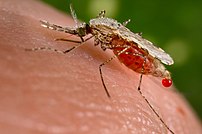
[amazon_link asins=’B072NSQDJC,B01LE6OTUK,B01FZKMK2K’ template=’ProductCarousel’ store=’finmeacur-20′ marketplace=’US’ link_id=’9c9bbb2a-297a-11e7-bd0c-cdf83f48d333′]
[amazon_link asins=’B00004R9VZ,B00I0G0JXE,B0117K6ZLY,B0002568YA,B000PGE032,B01LMKIGB6,B000HMA7OK,B01GN6M7UA’ template=’ProductCarousel’ store=’finmeacur-20′ marketplace=’US’ link_id=’c0a72e4d-297a-11e7-a491-6f2b385b0346′]
People living in countries like India, Bangladesh, Myanmar and Sri Lanka, bordering the Indian Ocean and Arabian Sea, have recently been suffering from high fever, red rashes, muscle aches and incapacitating and excruciating joint pain. The disease, chikungunya, has now assumed epidemic proportions. It disregards economic status and affects everyone, from the poor farmer in his hut to the well-heeled businessman in his mansion. Entire families, housing colonies, villages and townships suffer together.
It starts suddenly and as the small joints of the hands and feet are affected the person is unable to walk. It fells a previously healthy person to the ground. Once the fever subsides, the joint pain remains for around 10-15 days in the young, 1-2 months in the middle aged and 3-6 months or even five years in older people. Work comes to a grinding halt as the patient is prostrate with a headache and joint pain.
High fever and joint pain can appear acutely in other infections like dengue, malaria or filaria. Joint pains caused by chikungunya last for months, so that it can be confused with non-infectious diseases like rheumatoid or osteoarthritis. Fortunately these diseases can be ruled out with X-rays and appropriate blood tests.
Chikungunya (meaning ‘bent over’ in an African tribal language) created confusion among physicians till it was rightly diagnosed during the present epidemic that started in 2006. Significantly, it wasn’t the first time that chikungunya was reported in India. In 1971 an epidemic of chikungunya was proven and documented in Calcutta.
Chikungunya is an arbo virus infection transmitted by the bite of the Aedes mosquito, a small, innocuous insect with an attractive striped body. As the mosquito is a daytime biter which is “domesticated”, entire families can be affected within a few days of each other. This is because, unlike the Culex and Anopheles mosquito species, which bite at dawn and dusk, the Aedes mosquito bites in broad daylight. It loves civilisation, and thrives and breeds prolifically in the new urban environment with open water storage, poor sewage disposal, and inadequate uncovered drains. It is a hardy survivor which requires only in a few millilitres of water to breed in, a quantity that easily accumulates in old tyres, upturned bottle caps and flower vases. It can also survive in luggage, clothes, cars, trains and planes and then be inadvertently carried by tourists from one place to another. The Indian epidemic has now spread to Italy and other countries in Europe. There is a reservoir of infection as the virus survives in warm blooded vertebrates like monkeys, rodents and birds.
Treatment for chikungunya is not very satisfactory. NSAIDs (nonsteroidal anti-inflammatory drugs) and paracetemol can be used for pain and fever. New studies have shown that 250mg of chloroquine (a drug used for malaria) once a day reduces joint pain. Patients become very frustrated as the response is slow and unpredictable. This makes them “doctor shop” and opt for non-conventional therapy. This can result in misdiagnosis and inappropriate treatment and may be dangerous.
There is no vaccine to prevent chikungunya. The only effective method is to prevent the mosquito bites. Since the bites occur in the daytime, mosquito nets are not effective. Keeping an affected individual in a net for 24 hours a day prevents the disease spreading to others in the house. The breeding of the mosquito should be prevented by eliminating breeding grounds.
As you walk, turn over bottles caps and coconut shells so that rainwater doesn’t accumulate and stagnate. Straighten sagging canvas and plastic coverings periodically.
Empty air conditioning and cooler trays. Alternatively, put a handful of salt into the tray so that mosquitoes cannot breed.
Do not place trays under potted plants. Empty pots and vases regularly.
Fix mosquito mesh on open tanks and wells.
Windows and doors can be “mosquito proofed” using inexpensive plastic mesh.
BTI (bacillus thurin giensis israelensis) is a naturally occurring bacterium that kills immature mosquito larvae. It is available with the government malaria control division. The substance is nontoxic to humans and can be dumped in stagnant brackish or slowly flowing water.
There are some hardy mosquito larva eating ornamental fish, like Gambusia and Poecilia (guppy), which can be added to public ponds, canals and sewers.
Coils, liquid repellents and mosquito mats are better avoided. They should not be used in places where there are children below the age of six months. They can cause respiratory allergy, and lead to wheezing and sneezing in susceptible individuals.
Many mosquitoes are now resistant to DDT and other commonly used insecticides so that they survive and reproduce despite regular spraying by government and private agencies. Spraying the environment with insecticides causes the development of “pesticide resistance” in mosquitoes and respiratory allergies in susceptible individuals. It is eventually counterproductive.
Sources: The Telegrapg (Kolkata, India)
Related articles by Zemanta
- Chikungunya
- Malaria Preventin and Travel
- Researchers Find Essential Proteins for Critical Stage of Malaria Transmission
- Mosquitoes’ Lives Cut Short
- Bugging mosquitoes in the fight against dengue
- Dengue Advice Tips
- Do “Natural” Cold Remedies Work?
- Clustering of dengue virus infections
- Detailed Information on Malaria

![Reblog this post [with Zemanta]](https://i0.wp.com/img.zemanta.com/reblog_e.png?w=580)










